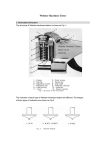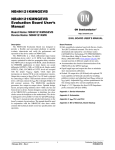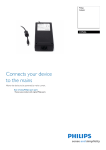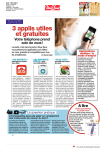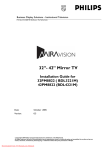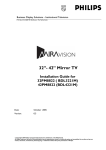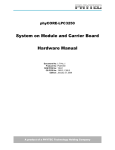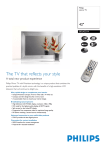Download Philips 23HM8821/12 Specifications
Transcript
Colour Television Chassis LC03E Miravision AA Miravision Range Supplement Manual to LC03E (3122 785 13571) F_15730_000.eps 300505 Contents Page 1. Technical Specifications, Connections, and Chassis Overview 2 2. Safety Instructions, Warnings, and Notes 3 3. Directions for Use 5 4. Mechanical Instructions 6 5. Service Modes, Error Codes, and Fault Finding 10 6. Block Diagrams, Test Point Overviews, and Waveforms 11 7. Circuit Diagrams and PWB Layouts 11 8. Alignments 11 9. Circuit Descriptions, List of Abbreviations, and IC Data Sheets 11 10. Spare Parts List 12 11. Revision List 13 © Copyright 2005 Philips Consumer Electronics B.V. Eindhoven, The Netherlands. All rights reserved. No part of this publication may be reproduced, stored in a retrieval system or transmitted, in any form or by any means, electronic, mechanical, photocopying, or otherwise without the prior permission of Philips. Published by BB 0566 Service PaCE Printed in the Netherlands Subject to modification EN 3122 785 15730 EN 2 1. LC03E MV AA Technical Specifications, Connections, and Chassis Overview 1. Technical Specifications, Connections, and Chassis Overview Index of this chapter: 1.1 Introduction 1.1 Introduction The Philips Mirror TV combines an interactive flat LCD TV together with the reflectivity of a mirror to provide an innovative 2 -in -1 product for the customer. The Mirror TV comes in several different models: • 17" Hallway 17HM8801 • 23" Hallway 23HM8801 • 23" Full screen 23HM8821 The Mirror TV product utilizes the existing LCD TV technology of the Philips 17" and 23" LCD models, and therefore it provides many of the same features. For familiarity purposes, the existing Directions For Use (DFU) documentation for the 17" and 23" LCD models can also be used for the Mirror TV. Some differences may apply, and these differences will be covered in the enclosed addendum sheet and Installation Guide (separately available via the ITV organisation). The MiraVision Installation Guide describes: • How to replace the decorative frame of the Mirror TV • How to wall mount the Mirror TV • Technical specifications of main components • Connectivity overview This supplement service manual describes various elements specific to the Mirror TV application. For common repairs on the electronics of the LCD panel reference is made to the service manual LC03E - 3122 785 13571. ComPair and SearchMan files are available with release 20033 (GB, DE and FR versions). The information in this document is subject to change. Accessories are subject to availability. For further specifications see service manual LC03E 3122 785 13571. Safety Instructions, Warnings, and Notes LC03E MV AA 2. EN 3 2. Safety Instructions, Warnings, and Notes Index of this chapter: 2.1 Safety Instructions 2.2 Warnings 2.3 Notes 2.1 • Safety Instructions Safety regulations require that during a repair: • Connect the set to the mains via an isolation transformer (> 800 VA). • Replace safety components, indicated by the symbol h, only by components identical to the original ones. Any other component substitution (other than original type) may increase risk of fire or electrical shock hazard. Safety regulations require that after a repair, the set must be returned in its original condition. Pay in particular attention to the following points: • Route the wire trees correctly and fix them with the mounted cable clamps. • Check the insulation of the mains lead for external damage. • Check the strain relief of the mains cord for proper function. • Check the electrical DC resistance between the mains plug and the secondary side (only for sets which have a mains isolated power supply): 1. Unplug the mains cord and connect a wire between the two pins of the mains plug. 2. Set the mains switch to the "on" position (keep the mains cord unplugged!). 3. Measure the resistance value between the pins of the mains plug and the metal shielding of the tuner or the aerial connection on the set. The reading should be between 4.5 Mohm and 12 Mohm. 4. Switch "off" the set, and remove the wire between the two pins of the mains plug. • Check the cabinet for defects, to avoid touching of any inner parts by the customer. 2.2 Warnings • • • • All ICs and many other semiconductors are susceptible to electrostatic discharges (ESD w). Careless handling during repair can reduce life drastically. Make sure that, during repair, you are connected with the same potential as the mass of the set by a wristband with resistance. Keep components and tools also at this same potential. Available ESD protection equipment: – Complete kit ESD3 (small tablemat, wristband, connection box, extension cable and earth cable) 4822 310 10671. – Wristband tester 4822 344 13999. Be careful during measurements in the high voltage section. Never replace modules or other components while the unit is switched "on". When you align the set, use plastic rather than metal tools. This will prevent any short circuits and the danger of a circuit becoming unstable. 2.3 Notes 2.3.1 General • Measure the voltages and waveforms with regard to the chassis (= tuner) ground (H), or hot ground (I), depending on the tested area of circuitry. The voltages and waveforms shown in the diagrams are indicative. Measure them in the Service Default Mode (see chapter 5) with a colour bar • • 2.3.2 Schematic Notes • • • • • • 2.3.3 signal and stereo sound (L: 3 kHz, R: 1 kHz unless stated otherwise) and picture carrier at 475.25 MHz for PAL, or 61.25 MHz for NTSC (channel 3). Where necessary, measure the waveforms and voltages with (D) and without (E) aerial signal. Measure the voltages in the power supply section both in normal operation (G) and in stand-by (F). These values are indicated by means of the appropriate symbols. The semiconductors indicated in the circuit diagram and in the parts lists, are interchangeable per position with the semiconductors in the unit, irrespective of the type indication on these semiconductors. Manufactured under license from Dolby Laboratories. “Dolby”, “Pro Logic” and the “double-D symbol”, are trademarks of Dolby Laboratories. All resistor values are in ohms and the value multiplier is often used to indicate the decimal point location (e.g. 2K2 indicates 2.2 kohm). Resistor values with no multiplier may be indicated with either an "E" or an "R" (e.g. 220E or 220R indicates 220 ohm). All capacitor values are given in micro-farads (µ= x10-6), nano-farads (n= x10-9), or pico-farads (p= x10-12). Capacitor values may also use the value multiplier as the decimal point indication (e.g. 2p2 indicates 2.2 pF). An "asterisk" (*) indicates component usage varies. Refer to the diversity tables for the correct values. The correct component values are listed in the Electrical Replacement Parts List. Therefore, always check this list when there is any doubt. Rework on BGA (Ball Grid Array) ICs General Although (LF)BGA assembly yields are very high, there may still be a requirement for component rework. By rework, we mean the process of removing the component from the PWB and replacing it with a new component. If an (LF)BGA is removed from a PWB, the solder balls of the component are deformed drastically so the removed (LF)BGA has to be discarded. Device Removal As is the case with any component that, it is essential when removing an (LF)BGA, the board, tracks, solder lands, or surrounding components are not damaged. To remove an (LF)BGA, the board must be uniformly heated to a temperature close to the reflow soldering temperature. A uniform temperature reduces the chance of warping the PWB. To do this, we recommend that the board is heated until it is certain that all the joints are molten. Then carefully pull the component off the board with a vacuum nozzle. For the appropriate temperature profiles, see the IC data sheet. Area Preparation When the component has been removed, the vacant IC area must be cleaned before replacing the (LF)BGA. Removing an IC often leaves varying amounts of solder on the mounting lands. This excessive solder can be removed with either a solder sucker or solder wick. The remaining flux can be removed with a brush and cleaning agent. After the board is properly cleaned and inspected, apply flux on the solder lands and on the connection balls of the (LF)BGA. Note: Do not apply solder paste, as this has shown to result in problems during re-soldering. EN 4 2. LC03E MV AA Safety Instructions, Warnings, and Notes be available till the end of the service period. For the repair of such sets nothing changes. Device Replacement The last step in the repair process is to solder the new component on the board. Ideally, the (LF)BGA should be aligned under a microscope or magnifying glass. If this is not possible, try to align the (LF)BGA with any board markers. So as not to damage neighbouring components, it may be necessary to reduce some temperatures and times. In case of doubt whether the board is lead-free or not (or with mixed technologies), you can use the following method: • Always use the highest temperature to solder, when using SAC305 (see also instructions below). • De-solder thoroughly (clean solder joints to avoid mix of two alloys). More Information For more information on how to handle BGA devices, visit this URL: http://www.atyourservice.ce.philips.com (needs subscription). After login, select “Magazine”, then go to “Workshop Information”. Here you will find Information on how to deal with BGA-ICs. 2.3.4 Caution: For BGA-ICs, you must use the correct temperatureprofile, which is coupled to the 12NC. For an overview of these profiles, visit the website www.atyourservice.ce.philips.com (needs subscription, but is not available for all regions) You will find this and more technical information within the "Magazine", chapter "Workshop information". For additional questions please contact your local repair help desk. Lead Free Solder Philips CE is going to produce lead-free sets (PBF) from 1.1.2005 onwards. 2.3.5 P Practical Service Precautions • b Figure 2-1 Lead-free logo This sign normally has a diameter of 6 mm, but if there is less space on a board also 3 mm is possible. Regardless of this logo (is not always present), one must treat all sets from this date onwards according to the following rules. Due to lead-free technology some rules have to be respected by the workshop during a repair: • Use only lead-free soldering tin Philips SAC305 with order code 0622 149 00106. If lead-free solder paste is required, please contact the manufacturer of your soldering equipment. In general, use of solder paste within workshops should be avoided because paste is not easy to store and to handle. • Use only adequate solder tools applicable for lead-free soldering tin. The solder tool must be able – To reach at least a solder-tip temperature of 400°C. – To stabilise the adjusted temperature at the solder-tip. – To exchange solder-tips for different applications. • Adjust your solder tool so that a temperature around 360°C - 380°C is reached and stabilised at the solder joint. Heating time of the solder-joint should not exceed ~ 4 sec. Avoid temperatures above 400°C, otherwise wear-out of tips will rise drastically and flux-fluid will be destroyed. To avoid wear-out of tips, switch “off” unused equipment or reduce heat. • Mix of lead-free soldering tin/parts with leaded soldering tin/parts is possible but PHILIPS recommends strongly to avoid mixed regimes. If not to avoid, clean carefully the solder-joint from old tin and re-solder with new tin. • Use only original spare-parts listed in the Service-Manuals. Not listed standard material (commodities) has to be purchased at external companies. • Special information for lead-free BGA ICs: these ICs will be delivered in so-called "dry-packaging" to protect the IC against moisture. This packaging may only be opened short before it is used (soldered). Otherwise the body of the IC gets "wet" inside and during the heating time the structure of the IC will be destroyed due to high (steam)pressure inside the body. If the packaging was opened before usage, the IC has to be heated up for some hours (around 90°C) for drying (think of ESD-protection!). Do not re-use BGAs at all! • For sets produced before 1.1.2005, containing leaded soldering tin and components, all needed spare parts will • It makes sense to avoid exposure to electrical shock. While some sources are expected to have a possible dangerous impact, others of quite high potential are of limited current and are sometimes held in less regard. Always respect voltages. While some may not be dangerous in themselves, they can cause unexpected reactions - reactions that are best avoided. Before reaching into a powered TV set, it is best to test the high voltage insulation. It is easy to do, and is a good service precaution. Directions for Use 3. Directions for Use 3.1 Introduction For familiarity purposes, the existing Directions For Use (DFU) documentation for the LCD models can also be used for the Mirror TV. Some differences may apply, and these differences will be covered in the Installation Guide (separately available via the ITV organisation). You can download the LC4.6E information from the following websites: http://www.philips.com/support http://www.p4c.philips.com LC03E MV AA 3. EN 5 EN 6 4. LC03E MV AA Mechanical Instructions 4. Mechanical Instructions Index of this chapter: 4.1 Introduction 4.2 Precautions 4.3 Handling broken mirror glass 4.4 Removing the mirror glass 4.5 Removing Back Cover 4.6 Internal Cabling 4.7 Handling of the Display 4.8 Mounting the Display Back in Place 4.9 How to Replace IR Sensor 4.4 Removing the mirror glass If it becomes necessary to remove the mirror glass (e.g. due to damage, or breakage), the screws securing the display (and the display) must be removed (see section Display Removal). In the case of the hallway models, there are additional securing screws (M3x4.5) used to hold the upper mirror in place (i.e. not just the screws that hold the display in place). These must also be removed. Notes: • Figures below can deviate slightly from the actual situation, due to the different set executions. • Follow the disassemble instructions in described order. 4.1 Introduction The Mirror TV product utilizes the existing LCD TV technology of the Philips 17" and 23" LCD models, and therefore it provides many of the same features. For familiarity purposes, the existing Directions For Use (DFU) documentation for the 17" and 23" LCD models can also be used for the Mirror TV. Some differences may apply, and these differences will be covered in the enclosed addendum sheet and Installation Guide (separately available via the ITV organisation). • How to replace the decorative frame of the Mirror TV • How to wall mount the Mirror TV F_15730_013.eps 270505 Figure 4-1 Mirror glass removal 4.2 Precautions Before starting to service: • Place a clean dry soft cloth on the table, to avoid damaging the frame. • Only open the mirror TV in a clean environment. Avoid ingress of dust, particularly on back of mirror. • Wear gloves to service the set due to extreme sensitivity to damages of the mirror and frame. • Do not touch the rear side of the glass with bare hands. • Due to the special surface used on the rear of the mirror, surface should only be cleaned with a clean dry cloth (DO NOT USE any cleaning agents or solvents). • MiraVision TVs should be received for repair without customized frames fitted, as Philips cannot be held liable for any damage done during service to customers' own frames. Frames are attached to the TV by screws from behind. • Packaging: Keep one of each box size at each service centre (standard Outer packaging). Packaging is available via Euroservice warehouse (see spare parts list). 4.3 Handling broken mirror glass When a MiraVision TV is sent to service for replacement of a broken mirror glass, it is important to follow safety guidelines to avoid any risk of injury: • Carefully remove all loose pieces of broken glass. • Remove display from frame, following guidelines given above, watch out for loose glass fragments. • Once display is removed, carefully remove the broken mirror glass. • Check for damage to the display. If badly damaged (i.e. impact on image quality is likely), consider replacement. • Insert replacement glass, wearing soft gloves to avoid risk of damage or marks. Mechanical Instructions 4.5 4.6 Removing Back Cover Remove back cover, by opening the screws (M4x5) located at the center back of the cover. LC03E MV AA 4. EN 7 Internal Cabling Disconnect the cables from the LCD display to back cover. Two cables must be disconnected when removingthe back cover (speakersa and STBY switch). F_15730_001.eps 260505 F_15730_004.eps 260505 Figure 4-2 Figure 4-5 4.7 Handling of the Display Once removed from the mirror TV, the display and LC4.6E chassis can be accessed and repaired in the normal way (see LC4.6E service manual). But again, do not remove the display from the set, unless the fault relates to the LCD panel. F_15730_002.eps 260505 Figure 4-3 Remove the screws (M4x5) located at the sides of the metal frame. F_15730_005.eps 260505 Figure 4-6 Note: The display has a strip of foam attached to it all around the perimeter of the front face, to allow even contact with the front part of the mirror TV aluminum frame. Aluminium Rim of LCD Panel Shorter foam LCD Panel Display Area F_15730_003.eps 260505 Figure 4-4 Longer foam F 15730 007.eps Figure 4-7 Front part EN 8 4. LC03E MV AA Mechanical Instructions The function of foam is to give some pressure to the glass to prevent dust penetrating between glass and LCD panel, and to ensure even contact between glass and frame. Foam dimensions are 400x10x3 (long side), 227.6x10x3 (short side) for the 17" panel and 528x10x3 (long side), 305.6x10x3 (short side) for the 23" panel. 4.8 Mounting the Display Back in Place When placing the display back in position, it is important to lower it carefully back into place (establish a firm hold on the display/ chassis), minimising risk of scratching or damaging the rear surface of the mirror glass. Care should be taken not to over tighten the screws, in order to avoid possible deformation of the glass and image distortion. Note: Before returning the defective LCD panel take care for total removal of the foam. Use a hair dryer to warm the space between the foam and the frame so that the foam can be torn off easily. Residual glue can be removed with some alcohol. 4.9 F_15730_009.eps 270505 Figure 4-9 How to Replace IR Sensor Access of IR sensor is only possible when decorative frame is removed. Instructions about replacing the decorative frame are given in chapter 3 of the Mirror TV Installation Guide. The IR sensor is removed by removing a securing screw (M3x4.5) at the front of the aluminium frame. The connection cable passes through the hole provided in the aluminium frame, allowing full removal and replacement of the IR sensor. Take care that screws of correct length (self tapping D3.5x12.5) are used if fitting a customised frame (they should not penetrate front of the frame). Normally, the workshop will not receive the set with customized frames fitted. F_15730_010.eps 270505 Figure 4-10 F_15730_008.eps 270505 Figure 4-8 F_15730_011.eps 270505 Figure 4-11 Mechanical Instructions F_15730_012.eps 260505 Figure 4-12 LC03E MV AA 4. EN 9 EN 10 5. LC03E MV AA Service Modes, Error Codes, and Fault Finding 5. Service Modes, Error Codes, and Fault Finding 5.1 ICONN Switch Check the position of the ICONN switch if Mirror TV does not respond to the Remote control. See also Annex B of the Mirror TV Installation guide. Normally signals from the remote control go directly to the Mirror TV (left side picture). After rerouting the remote control signals and installing the connectivity box, remote control commands have to go via the connectivity box to the Mirror TV (right side picture). F_15730_014.eps 270505 Figure 5-1 Locate the small hole at the rear side of the Mirror TV as indicated in the following picture: F_15730_015.eps 270505 Figure 5-2 Use a paperclip or thin screwdriver to (de)press the switch located behind the small hole. The switch must be put in position B to reroute the RC commands. Now the Mirror TV will only operate with the Connectivity box connected. For further service modes, error codes, and fault finding see service manual LC03E 3122 785 14711 Block Diagrams, Test Point Overviews, and Waveforms LC03E MV AA 6. EN 11 6. Block Diagrams, Test Point Overviews, and Waveforms See service manual LC03E 3122 785 13571 7. Circuit Diagrams and PWB Layouts See service manual LC03E 3122 785 13571 8. Alignments See service manual LC03E 3122 785 13571 9. Circuit Descriptions, List of Abbreviations, and IC Data Sheets See service manual LC03E 3122 785 13571 EN 12 10. LC03E MV AA 10. Spare Parts List 3139 128 77371 Speaker assy for 23” DBB298N 3139 128 77381 Speaker assy for 17" DBC298N 3139 124 01411 Cable tie - ferrite ring 3139 188 69022 Speaker switch assy 3139 188 69032 IR module with wire assy 3139 124 61561 IR lens 3139 124 90111 Mirror TV glass 17HW 3139 124 90121 Mirror TV glass 23HW 3139 124 90131 Mirror TV glass 23FS 3139 123 22111 Foam LCD17 400x10x3 3139 123 22121 Foam LCD17 227.6x10x3 3139 123 22131 Foam LCD23 305.6x10x3 3139 123 22141 Foam LCD23 528x10x3 3139 123 01241 Wooden decorative frame 17HW 3139 123 01261 Wooden decorative frame 23HW 3139 123 01251 Wooden decorative frame 23FS 3139 120 41641 Screws - self tapping D3.5x12.5 3128 147 14871 Remote Control 3139 126 83101 Packing (outer box with buffers) 17HW 3139 126 83081 Packing (outer box with buffers) 23HW 3139 126 83091 Packing (outer box with buffers) 23FS Spare Parts List Revision List 11. Revision List Manual xxxx xxx xxxx.0 • First release. LC03E MV AA 11. EN 13













